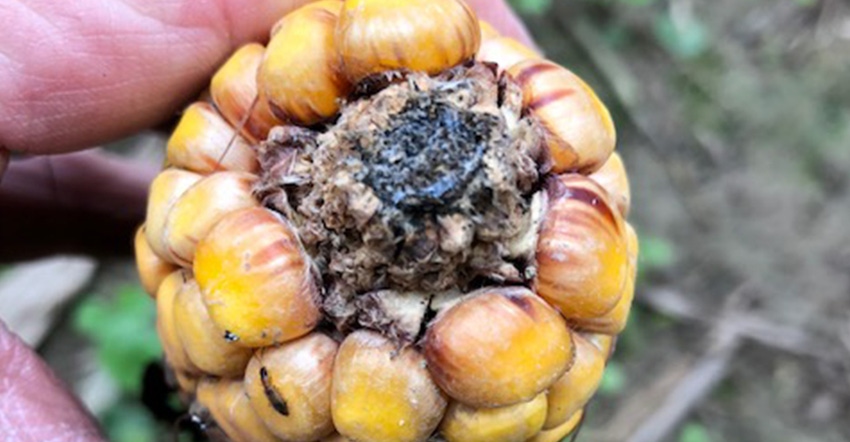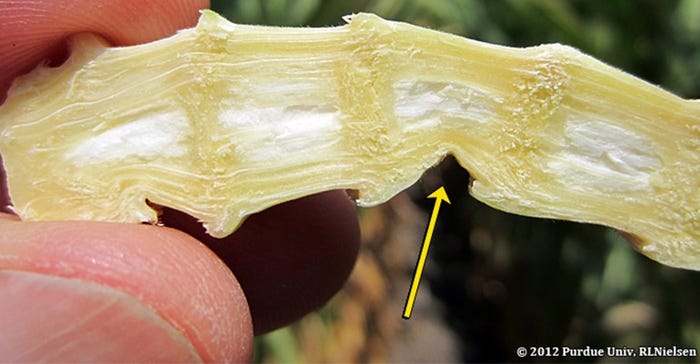October 1, 2019

Sponsored Content
Ears on the ground prior to harvest is frustrating and often misunderstood. Pest damage, weather stress, reduced nitrogen (N) uptake, and genetics can all contribute to dropped ears. However, identifying the causal agent may help you implement strategies and management practices to minimize ear drop in the future.
Conditions that Contribute to Ear Drop
Limited N uptake at early silk development: N is a vegetative nutrient and if it’s limited during silk elongation, the base end of the ear may be barren and potentially cause ear drop.
Moisture stress during pollination/silking: The shank of the ear develops during the two-week period surrounding pollination. Extreme moisture and/or heat stress during this time can interfere with shank development resulting in a “drought” shank or reduced shank diameter.
Favorable growing conditions following heat and/or drought stress at pollination: Favorable weather during grain fill following pollination and shank development promotes kernel depth and kernel weight. Weak shanks developed during pollination cannot support the weight of the heavier ears.
Insect feeding: European corn borer larvae can tunnel into the ear shank in hybrids that do not contain a Bt-corn borer trait, reducing its ability to retain the ear. Evidence of corn borer feeding is a hole in the ear shank and frass at the entry point.

Why are Some Hybrids More Vulnerable?
Some hybrids are genetically predisposed to produce a smaller-diameter shank attachment, even during adequate growing conditions. During drought stress, certain hybrids are able to set more kernels than others. Hybrids with excellent drought tolerance can set very large ears but may have relatively weak ear shanks to support the weight. Hybrids that dry down rapidly are also more likely to experience brittle tissue where the ear attaches.
Some hybrids also have a longer ear shank, which may be weakened due to stress at pollination. If good growing conditions follow, the ear will fill out and be heavy relative to the shank. The strain of the ear’s leverage may break the shank, causing the ear to drop.
Ear drop can vary by planting date as well as relative maturity. If the timing of drought or heat stress conditions coincides with pollination and ear shank development, it can reduce the shank diameter and ovule pollination on the butt-end of the ear. Since N and water availability impact silk elongation, N management and soil water-holding capacity (organic matter (OM)) also affect ear drop.
Minimizing Losses from Ear Drop
Focus early harvest efforts on the following field situations:
Nitrogen may have been limited – N loss due to volatility, leaching, denitrification
Stress at pollination – heat or drought
Lower water-holding capacity soils – coarse-textured or low OM
Non-GMO hybrids
Problem fields:
Harvest as soon as possible
Adjust header height as close to the ear as possible to reduce stress on the ear shank
Run head speed as slow as possible to minimize plant shaking

Impact on Yield
Ears on the ground are readily apparent and often appear worse than the overall impact to final yield. As a rule of thumb, it takes about 150 ears to make a bushel. To determine estimated yield loss, count the number of dropped ears in 1/100th of an acre. The charts below provide yield loss estimates based on row width and swath width.

The impact of ear drop on yield is often not as bad as it seems at first. Scouting fields and counting dropped ears is a crucial step to forming a harvest plan. It is too late to go back and plant differently, or add more nitrogen- but you can limit losses by harvesting the grain before wind and weather cause more shanks to fail and ears to drop. Prioritize harvest in affected fields, and remember that in 2020 you may need to take special measures to control volunteer corn in fields with severe ear drop. 2019 has been a showcase year for agronomic challenges- stay focused on safely completing harvest, then look at head to your 2020 vision.
About the Author(s)
You May Also Like




